- Home
- Paint a Hummingbird
You Can Confidently Paint a Hummingbird with Beautiful Iridescent Colors
How to paint a hummingbird with oil paints.
Actually I use alkyd paints, but they look and handle just like oils. They are my favorite painting medium because all the colors dry overnight with a lovely soft sheen.
We will paint the beautiful male Broad-billed Hummingbird that has a dark metallic green body with a blue throat. It's easy to identify with its dark-tipped red bill.
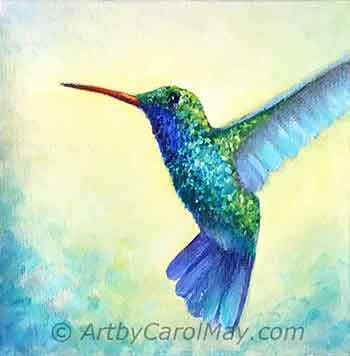 Paint a Broad-billed Hummingbird.
Paint a Broad-billed Hummingbird.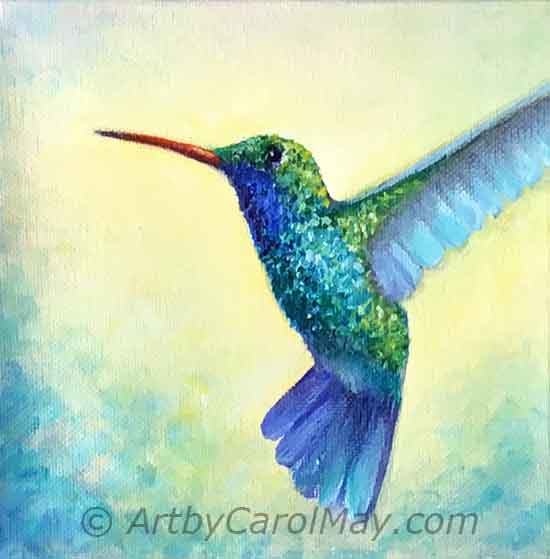 Paint a Broad-billed Hummingbird.
Paint a Broad-billed Hummingbird.Get Ready to Paint
What supplies do you need to paint your hummingbird?
Canvas and Colors
This painting is on a 6"x6", 1 1/2" thick gallery-wrap canvas.
- blue
- yellow
- green
- red
- purple, optional
The background is going to be yellow. Purple on the bird would complement the yellow background.
There is hardly any purple on the bird. So if you don't want purple on your hummer, there is no need to put it on your palette.
Of course you will need some white.
If you are brand new to oil painting, you can find answers to frequent questions about oil painting here.
How to Paint a Hummingbird
The fun part of doing a painting on a gallery-wrapped canvas is carrying the painting over the edge to the side of the canvas.
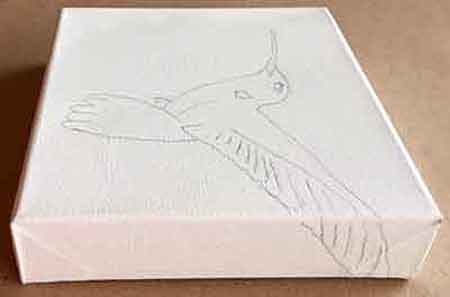 Draw the Hummingbird
Draw the HummingbirdDo the drawing on a separate paper and transfer it to the canvas with graphite paper.
If you are good at drawing, just draw the hummingbird directly on the painting surface with an ordinary #2 pencil.
**Before you start painting, always decide what direction the light will come from. For the sake of reality and interest, any items in the painting will have a light side and a darker side.
In this painting the light will come from the upper right.
The Underpainting
The underpainting gives us the roadmap of what colors will be used where. Thin the colors with solvent.
**Lay in a thin layer of the colors with 1/2" brush. There is no need to try and get the colors smooth and perfect looking.
This is just the underpainting. We will be adding more paint on top of the underpainting. Then the colors will smooth out.
The two basics of oil painting are; paint thin to thick and paint dark to light.
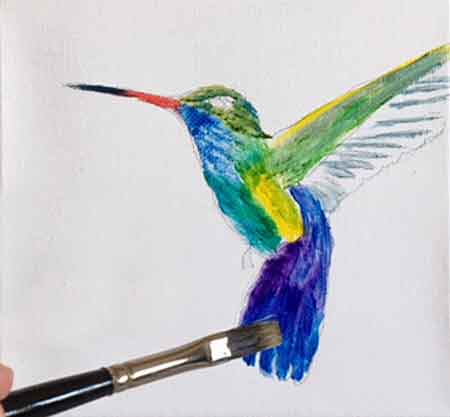 Underpaint the Hummingbird
Underpaint the HummingbirdIn a similar manner under paint the background with yellow around the hummingbird.
Use a darker color like purple or blue around the edges of the canvas to help hold the eye in the painting.
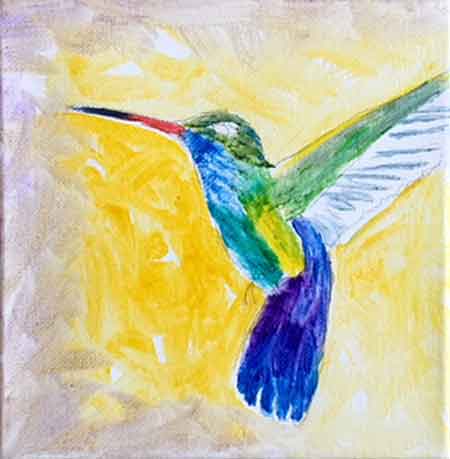 Underpaint the Background
Underpaint the BackgroundPaint the Background
Use the same brush and blend white into the underpainting. No solvent with the white, this is the thick layer.
The white blends with the underpainting and the colors will smooth out.
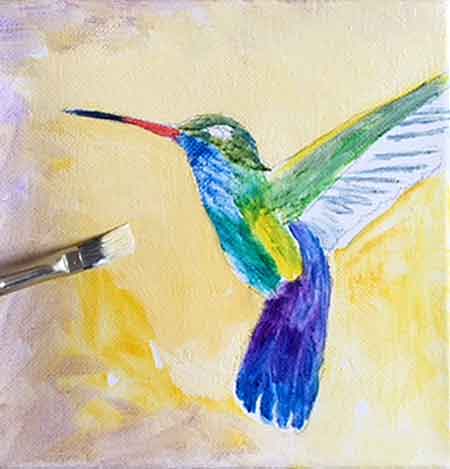 Finish Painting the Background
Finish Painting the BackgroundStart painting next to the bird and paint out to the edge and down over the sides of the canvas.
Finish the background before painting the hummingbird.
Paint the Edge of the Gallery-wrap Canvas
Choose a coordinating color and paint the sides of your gallery
wrapped canvas.
First I chose lavender, but later changed it to a blue that looked better with the hummingbird.
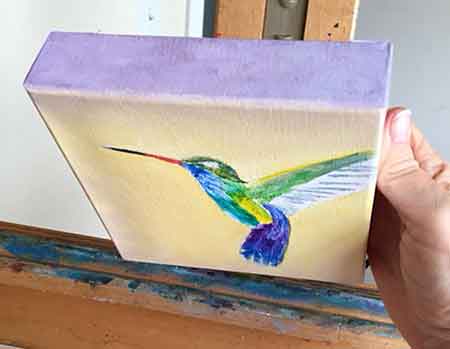 Paint the sides of the canvas.
Paint the sides of the canvas.Gallery wrapped canvas is great because the finished painting does not need a frame.
Paint the Hummingbird
The hummer is small, so a smaller brush like a 3/8" is good.
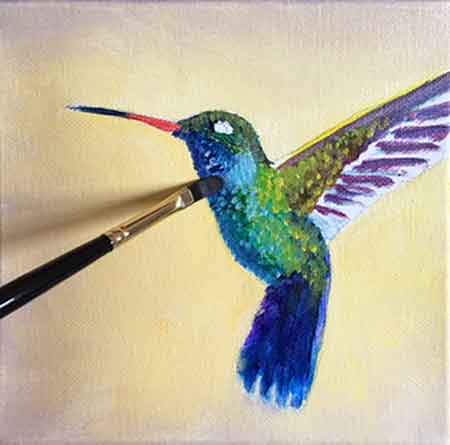 Paint the Hummingbird
Paint the HummingbirdAlways paint dark to light when you are using oil paint.
Paint the dark colors with a thin layer. Then the next layer of paint will be thicker and it will lie down over the thin layer.
Notice the left of the hummer is darker because it is farther from the light.
Now use the corner of the brush to touch dots of thicker, lighter color on top of the dark colors.
The contrast of the light on top of the dark is what makes the iridescent colors shine.
It's fun learning to paint a hummingbird!
Detail the Hummingbird
Adjust anything that doesn't look good to you.
In the photo above, it looked like he was wearing a girdle. So I pulled his belly out thicker and added
more tail feathers up at an angle to give him more flare.
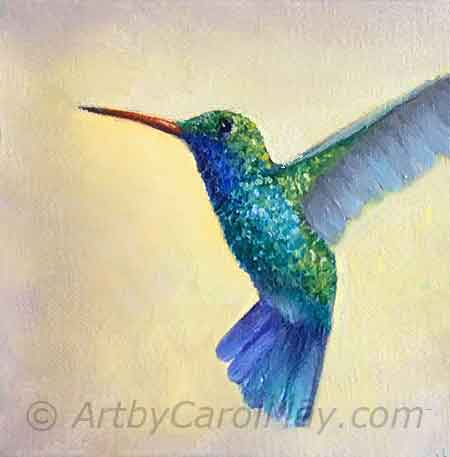 Paint the Details
Paint the DetailsA good rule of thumb when you are learning how to paint a hummingbird is to always use the largest brush possible. This gives your painting more freedom. In this case because the details were so small, I switched to a 1/4" brush.
Paint the hummer's eye with a dark color. Touch a tiny highlight on the eye with the corner of your brush.
Use white mixed with a speck of blue. White is rarely used straight out of the tube. Always tone it down with a small amount of color.
Paint the patch behind the eye with a subdued white.
Always remember when you are painting hummingbirds that many types of hummingbirds have a white patch behind their eye. The male Broad-bill has a subdued white patch.
Paint a shadow on the bottom of the hummer's bill. Put a yellow highlight on the top of the bill. Redefine the dark tip of the bill and adjust the shape if necessary.
If the bill is too thick, mix some of the background yellow and use it to trim down the thickness of the bill.
Finishing Touches
Learning to see with an artist's eye is part of learning how to paint a hummingbird.
Look at your painting and see what you want to adjust.
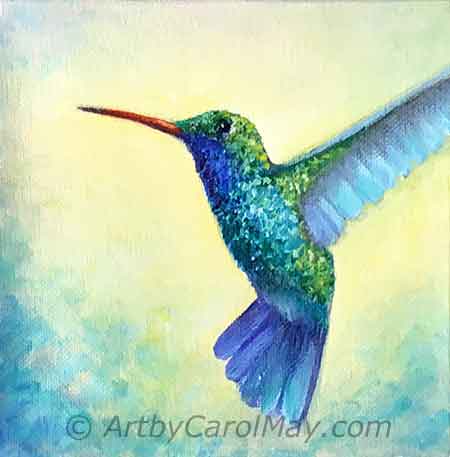 Final Adjustments
Final AdjustmentsHighlight the top of the wing and put a shadow under the edge before the feathers start.
In real life the Broad-billed Hummingbird has brownish colored wing feathers. To my artist's eye, brown didn't fit with the rest of the painting. So I changed the wing feathers to a bluish color.
Adding more blue around the edges of the background helped tie the background to the hummingbird.
Underpaint the feathers. Then with a lighter version of the same color, pull a highlight on the edge of the feathers toward the top of the wing.
The individual strokes give the indication of feathers.
Paint the bottom edge of the gallery-wrap canvas.
Leave to canvas upside down on the easel or lay it on a paper towel to dry the edge of the canvas.
Now It's Your Turn!
Now you know how to paint a hummingbird with oil paints. Get a canvas or two or three and practice.
Don't be hard on yourself.
We all start somewhere and the more you paint the better your paintings will be.





















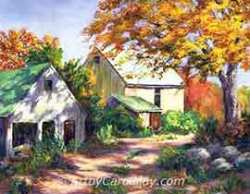 Art elements and principles appear over and over in good paintings. The elements and principles work together for us to create successful artwork. Art principles are the rules that govern how an artis…
Art elements and principles appear over and over in good paintings. The elements and principles work together for us to create successful artwork. Art principles are the rules that govern how an artis…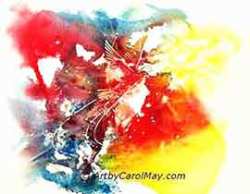 Artists often use the meaning of color to convey emotions, sentiments, and symbolism. Are you intrigued by the idea that colors can enhance or suppress different aspects of your paintings? Let's look…
Artists often use the meaning of color to convey emotions, sentiments, and symbolism. Are you intrigued by the idea that colors can enhance or suppress different aspects of your paintings? Let's look…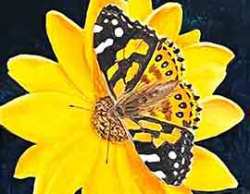 What is the best painting medium for the artist to begin painting? Compare the pros and cons of today’s popular mediums, oil, watercolor, acrylic and alkyd paint. What is the difference between their…
What is the best painting medium for the artist to begin painting? Compare the pros and cons of today’s popular mediums, oil, watercolor, acrylic and alkyd paint. What is the difference between their…